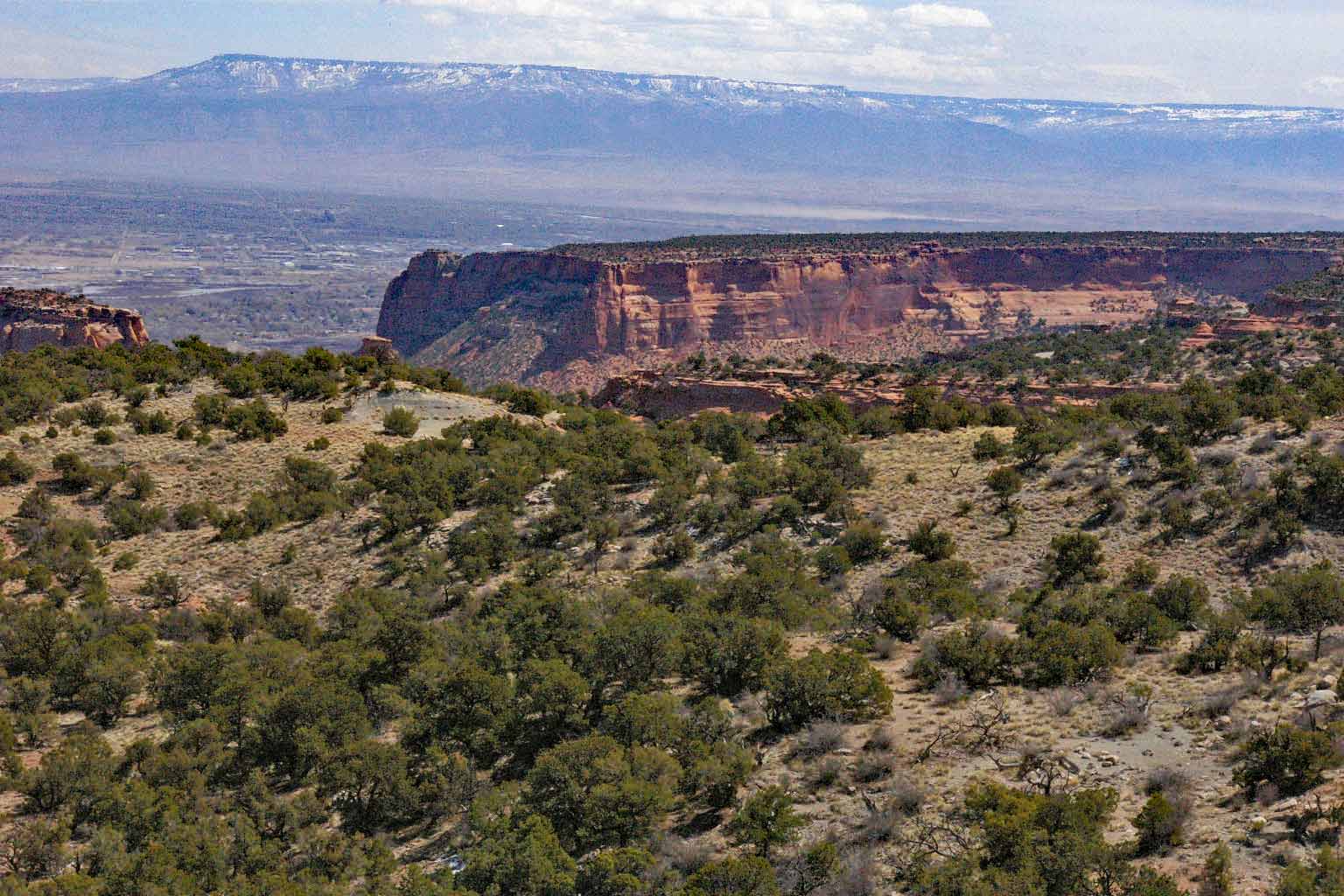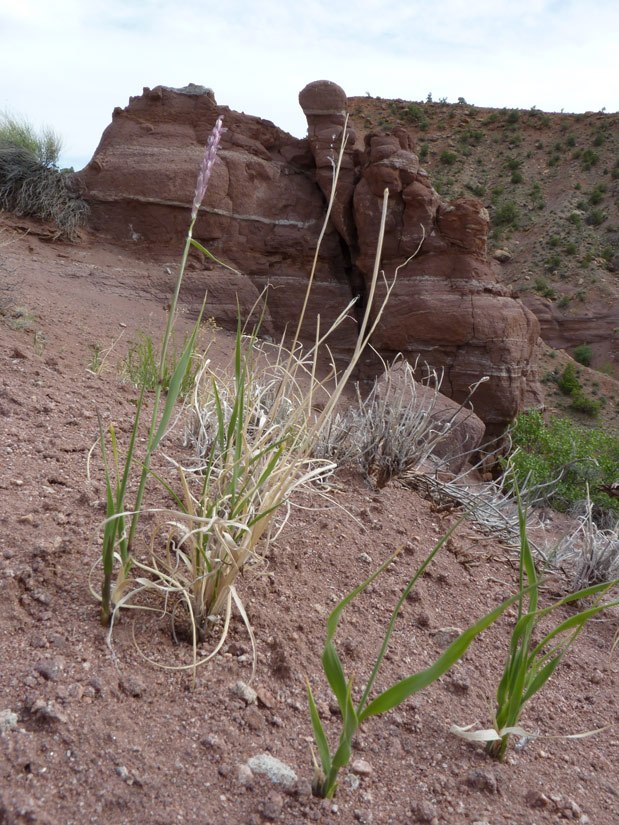Colorado Plateau Pinyon-Juniper Woodland
Colorado National Monument, Mesa County
Colorado Pinyon-Juniper
Woodland & Savanna
Pinyon-juniper woodlands occur on the eastern and western slopes of Colorado in a thin band of altitude between 4,500 and 7,500 feet, between grasslands on the eastern slope and shrublands on the western slope at lower elevations to ponderosa pine forests in higher areas. It is believed that the lower and higher altitudes of this community are determined by severe climatic events occurring during the growing season, such as frosts and drought.
Both pinyon (Pinus edula) and juniper (Juniperus) species are well adapted to dry conditions because both have deep tap roots and wide-spreading surface roots to take advantage of downpours from thunderstorms. However, junipers are more drought resistant than pinyons and appear more abundantly in forests at lower and drier elevations, whereas pinyons prefer slightly wetter situations and are more abundant in these forests at higher elevations. In the driest areas at lower elevations, pinyon pines drop out of this community completely resulting in pure Juniperus osteosperma woodlands and savanna communities.
On the eastern slope, a third species of juniper, Rocky Mountain Juniper (Juniperus scopulorum), may co-dominate or replace both juniper species at higher elevations.
An interesting aspect of pinyon-juniper forests in Colorado is that although they occur on the western slope and the southern counties of the eastern slope, the juniper species are different in both areas. On the western slope the juniper species is Utah Juniper (Juniperus osteosperma), and on the eastern slope the juniper species is One-seed Juniper (Juniperus monosperma), although J. monosperma does occur in the southern counties of the western slope as well. This pattern is also repeated in the sagebrush indicator species of the understory. Artemisia tridendata is found on the western slope and Artemisia biglovii is found in the southern counties of the eastern and western slopes.
Pinyon-juniper woodlands have a variety of stand structures and compositions, depending on the local climate, topography, growing conditions and fire regimes. Pinyon-juniper savannas have low densities of trees and shrubs, with high density of herbs and grasses. They occur in gentle terrain, valleys, basins and foothills.
Some Commonly Associated Plants
Click on photo to see full-page lightbox image.
In lightbox, click on X in upper right corner to return here.
Galleta Grass (Hilaria jamesii)
Precipitation comes primarily in the form of monsoon rains during the growing season, and low intensity surface fires clear the ground of vegetation. These savannas are found in Moffat County in the northwest corner of the state and the southeast counties of Las Animas, Baca, Bent Otero and Pueblo.
Pinyon-juniper shrublands, grow on plains, valleys and lower montane and have variable mosaic of plant dominance from herbs to shrubs to trees depending on the absence of fire. They are often shrub dominated with trees colonizing the stand when growing conditions are favorable. Their precipitation comes mostly during winter. These communities are subject to both low and high intensity fires. They are found in the counties all along the western border with Utah.
Pinyon-juniper woodlands are found in steep, rocky terrain and rugged upland sites, cliffs, canyons with lots of exposed rock and think soils. These woodlands have a wide range of tree densities and have a sparse herb and shrub cover. They receive their precipitation either mostly in the winter or bimodally, in the winter and and during the summer monsoons. They are subject mostly to high intensity fires.
Pinyon pines and junipers are so effective at extracting moisture from the soil, that as their density increases, plants in the understory decrease. On the western slope the diagnostic understory shrubs are Manzanita (Arctostaphylos patula), Black Sagebrush (Artemisia nova), Big Sagebrush (Artemisia tridentata), Dwarf Mountain Mahogany (Cercocarpus intricatus), Stansbury’s Cliffrose (Purshia stansburiana), Antelope Bitterbrush (Purshia tridentata), and Galleta (Hilaria jamesii). Some diagnostic grasses are Bluebunch (Pseudoroegneria spicata), Sanberg Bluegrass (Poa secunda), and muttongrass (Poa fendleriana).
On the eastern slope Gambel Oak (Quercus gambelii) may be present and some common understory shrubs are Bigelow’s Sagebrush (Artemisia bigelovii), Birchleaf Mountain Mahogany (Cercocarpus montanus) and Apache Plume (Fallugia paradoxa). Some common grasses are Nelson’s Needlegrass (Eriocoma nelsonii), Scribner’s Needlegrass (Eriocoma scribneri), Blue Gramma (Bouteloua gracilis), Arizona Fescue (Festuca arizonica), and Galetta (Hilaria jamesii).
– Mo Ewing
Credits and More Reading
Natureserve: Colorado Plateau Pinyon-Juniper Woodland
https://explorer.natureserve.org/Taxon/ELEMENT_GLOBAL.2.1085061/Pinus_edulis_-_Juniperus_osteosperma_Woodland_Group
National Park Service: Pinyon Juniper Woodlands – Introduction
https://www.nps.gov/articles/pinyon-juniper-woodlands-distribution.htm
Pinyon-Juniper Woodlands: Species Composition and Classification
https://www.nps.gov/articles/pinyon-juniper-woodlands-species-composition-classification.htm
Pinyon-Juniper Woodlands – Ecosystem Drivers, Disturbance Processes and Succession
https://www.nps.gov/articles/pinyon-juniper-woodlands-ecosystem-drivers-disturbance-succession.htm
Pinyon-Juniper Woodlands – Anthropogenic Use and Post-settlement Stressors
https://www.nps.gov/articles/pinyon-juniper-woodlands-anthropogenic-use.htm
Pinyon-Juniper Woodlands – Climate Change and Literature Cited
https://www.nps.gov/articles/pinyon-juniper-woodlands-climate-change-and-literature-cited.htm

